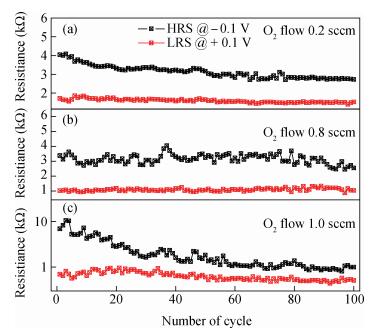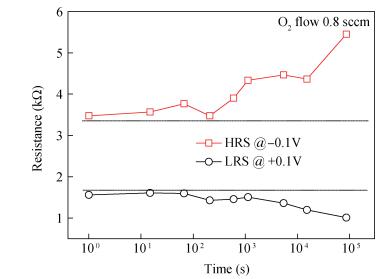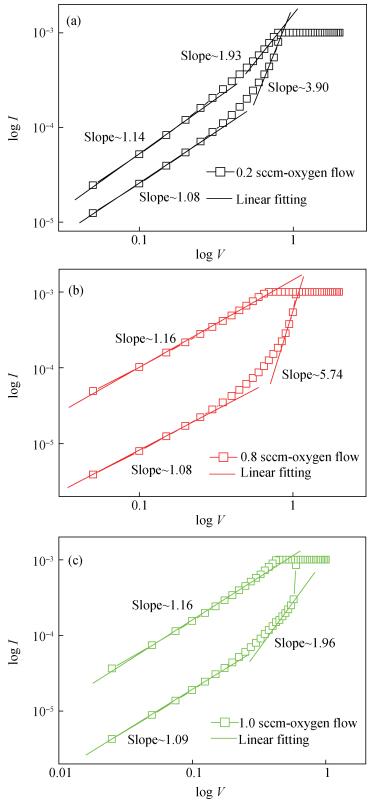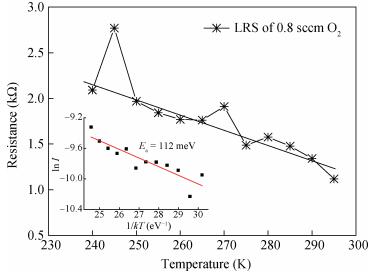| Citation: |
Da Chen, Shihua Huang, Lü He. Effect of oxygen concentration on resistive switching behavior in silicon oxynitride film[J]. Journal of Semiconductors, 2017, 38(4): 043002. doi: 10.1088/1674-4926/38/4/043002
****
D Chen, S H Huang, L He. Effect of oxygen concentration on resistive switching behavior in silicon oxynitride film[J]. J. Semicond., 2017, 38(4): 043002. doi: 10.1088/1674-4926/38/4/043002.
|
Effect of oxygen concentration on resistive switching behavior in silicon oxynitride film
DOI: 10.1088/1674-4926/38/4/043002
More Information
-
Abstract
SiOxNy films with different oxygen concentrations were fabricated by reactive magnetron sputtering, and the resistive switching characteristics and conduction mechanism of Cu/SiOxNy/ITO devices were investigated. The Cu/SiOxNy/ITO device with SiOxNy deposited in 0.8-sccm O2 flow shows a reliable resistive switching behavior, including good endurance and retention properties. As the conductivity of SiOxNy increases with the increase of the oxygen content dynamical electron trapping and detrapping is suggested to be the conduction mechanism. The temperature dependent I-V measurement indicates that the carrier transport can be ascribed to the hopping conduction rather than the metallic conductive filament. -
References
[1] Jo H S, Lu W. CMOS compatible nanoscale nonvolatile resistance switching memory. Nano Lett, 2008, 8: 392 doi: 10.1021/nl073225h[2] Tang S G, Zeng F, Chen C, et al. Resistive switching with self-rectifying behavior in Cu/SiOx/Si structure fabricated by plasma-oxidation. Appl Phys Lett, 2013, 113: 244502 https://www.researchgate.net/profile/Cheng_Song3/publication/257975035_Resistive_switching_with_self-rectifying_behavior_in_CuSiOxSi_structure_fabricated_by_plasma-oxidation/links/53f4879a0cf2fceacc6e8924.pdf?inViewer=true&pdfJsDownload=true&disableCoverPage=true&origin=publication_detail[3] Hezel R, Meisel T, Streb W. Silicon oxynitride films prepared by plasma nitridation of silicon and their application for tunnel metal insulator silicon diodes. J Appl Phys, 1984, 56: 1956 https://www.researchgate.net/publication/224533831_Silicon_oxynitride_films_prepared_by_plasma_nitridation_of_silicon_and_their_application_for_tunnel_metal-insulator-silicon_diodes[4] Snyder G P, Xiong M Y, Woollam A J, et al. Graded refractive index silicon oxynitride thin film characterized by spectroscopic ellipsometry. J Vac Sci Technol A, 1992, 10: 1462 doi: 10.1116/1.578266[5] Brinkmann N, Sommer D, Micard G, et al. Electrical, optical and structural investigation of plasma-enhanced chemical-vapor-deposited amorphous silicon oxynitride films for solar cell applications. Sol Energy Mater Sol Cells, 2013, 108: 180 doi: 10.1016/j.solmat.2012.09.025[6] Kapoor V, Bailey R, Smith S, et al. Impurities related memory traps in silicon nitride thin films. J Vac Sci Technol, 1981, 18: 305 doi: 10.1116/1.570747[7] Yang C P, Chang C T, Chen C S, et al. Influence of bias-induced copper diffusion on the resistive switching characteristics of a SiON thin film. Electrochem Solid-State Lett, 2011, 14: H93 doi: 10.1149/1.3518701[8] Chen Y T, Chang T C, Huang J J, et al. Influence of molybdenum doping on the switching characteristic in silicon oxide-based resistive switching memory. Appl Phys Lett, 2013, 102: 043508 doi: 10.1063/1.4790277[9] Akinaga H, Shima H. Resistive random access memory (ReRAM) based on metal oxides. Proc IEEE, 2011, 98: 2237 https://www.researchgate.net/publication/224184428_Resistive_Random_Access_Memory_ReRAM_Based_on_Metal_Oxides[10] Meng Y, Zhang P J, Liu Z Y, et al. Enhanced resistance switching stability of transparent ITO/TiO2/ITO sandwiches. Chin Phys B, 2010, 19: 037304 doi: 10.1088/1674-1056/19/3/037304[11] Deng N, Pang H, Wu W. Effects of different dopants on switching behavior of HfO2-based resistive random access memory. Chin Phys B, 2014, 23: 107306 doi: 10.1088/1674-1056/23/10/107306[12] Scopel L W, Fantini A M, Alayo I M, et al. Local structure and bonds of amorphous silicon oxynitride thin films. Thin Solid Films, 2002, 413: 59 doi: 10.1016/S0040-6090(02)00346-2[13] Philipp J R. Optical and bonding model for non-crystalline SiOx and SiOxNy materials. J Non-Cryst Solids, 1972, 8-10: 627 doi: 10.1016/0022-3093(72)90202-5[14] Sassella A. Tetrahedron model for the optical dielectric function of H-rich silicon oxynitride. Phys Rev B, 1993, 48: 14208 doi: 10.1103/PhysRevB.48.14208[15] Chang Y S, Huang C Y. Effect of plasma treatments on interface chemistry and adhesion strength between porous SiO2 low-k film and SiC/SiN layers. Microelectron Eng, 2008, 85: 332 doi: 10.1016/j.mee.2007.07.007[16] Jung S, Kim S, Oh H J, et al. Analysis of conduction mechanism in silicon nitride-based RRAM. Int J Nanotechnol, 2014, 11: 125 https://www.researchgate.net/publication/262992880_Analysis_of_conduction_mechanism_in_silicon_nitride-based_RRAM[17] Liu Y, Liu I K, Zhang X. Mechanical properties of sputtered silicon oxynitride films by nanoindentation. Mater Sci Eng A, 2008, 489: 294 doi: 10.1016/j.msea.2008.01.063[18] Tao M, Park D, Mohammad N S, et al. Electrical conduction in silicon nitrides deposited by plasma enhanced chemical vapour deposition. Philos Mag B, 1996, 73: 723 https://www.researchgate.net/publication/232898085_Electrical_conduction_in_silicon_nitrides_deposited_by_plasma_enhanced_chemical_vapour_deposition[19] Kennedy P G, Buiu O, Taylor S. Oxidation of silicon nitride films in an oxygen plasma. J Appl Phys, 1999, 85: 3319 doi: 10.1063/1.369678[20] Stato H, Kato H, Ohki Y, et al. Electrical properties in silicon oxynitride and silicon nitride prepared by plasma-enhanced chemical vapor deposition. Proceedings of 2001 International Symposium, Electrical Insulating Materials, 2001[21] Kim D H, An M H, Kim C K, et al. Large resistive-switching phenomena observed in Ag/Si3N4/Al memory cells. Semicond Sci Technol, 2010, 25: 065002 doi: 10.1088/0268-1242/25/6/065002[22] Chen A, Zhu G K, Zhong C H, et al. A new investigation of oxygen flow influence on ITO thin films by magnetron sputtering. Sol Energy Mater Sol Cells, 2014, 120: 157 doi: 10.1016/j.solmat.2013.08.036 -
Proportional views





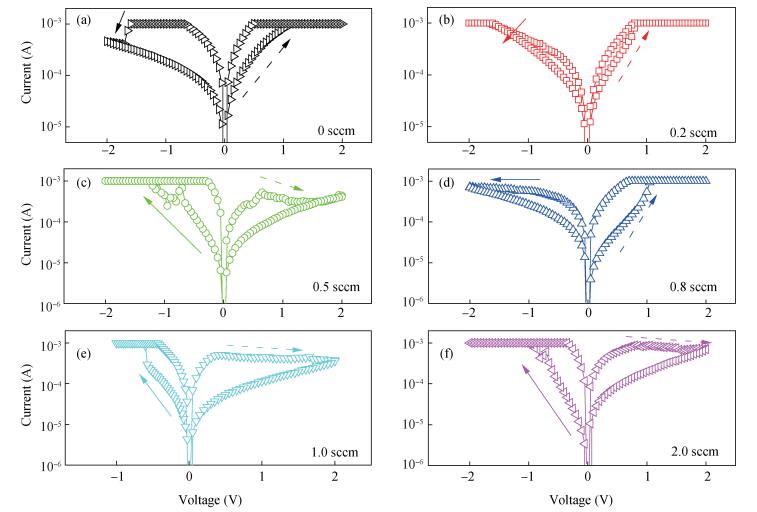
 DownLoad:
DownLoad:
